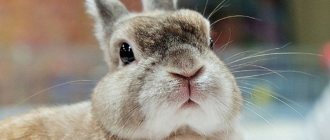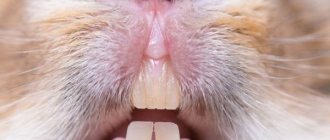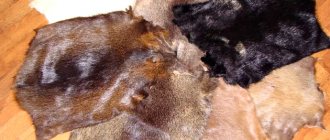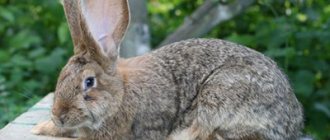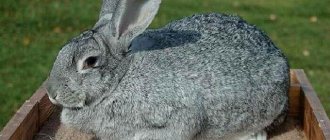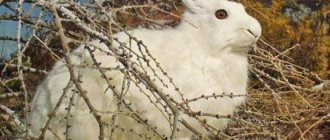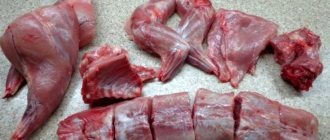Body temperature is a major indicator of health in both humans and animals. Its deviations indicate that pathological processes are occurring in the body. From this article, readers will learn what body temperature is considered normal in a rabbit. Pet owners should know what to do if the thermometer shows critical values.
The rabbit is sick
Belarus, Kazakhstan
In nature, rabbits are not afraid of high air temperatures: they take refuge in burrows. In captivity, where the rabbit is completely dependent on humans and is deprived of freedom, temperatures above + 28ºC can lead to heat stroke, even death of the animal
.
In addition, during the heat, the reproductive functions of animals suffer. Simply put, if it’s above + 22ºC outside, rabbits don’t want to breed or multiply and often they simply can’t
.
Signs of illness
There is no need to start taking your pet’s temperature for no reason. However, you should be wary if a warm body is combined with other signs of illness. These include:
- decreased activity;
- excited state;
- loss of appetite;
- decreased thirst;
- various changes in the mucous membrane, skin and coat;
- wet nose;
- sneezing;
- cough;
- wet dirt around the anus;
- diarrhea;
- constipation;
- purulent discharge from the eyes and nose.
You should be wary if signs of the disease are found in nearby rabbits.
Natural thermoregulation in rabbits
When the air temperature reaches 24-26º C, all animal thermoregulation systems are activated.
- Since rabbits do not sweat - they do not have sweat glands - they simply breathe very often so that more water evaporates and the body cools.
- In the heat, the rabbit spreads its ears as far as it can to the sides, increasing their contact with the air. The fact is that the animal’s ears are pierced by large and small blood vessels, which expand at high temperatures. The blood cools, followed by the body. The method gives a noticeable result when a breeze blows over the rabbits or a fan is located next to the cage.
- Cooling through objects. The thinnest hair on a rabbit is on its belly. That's why in the heat he stretches out on the floor.
Animals can cool themselves without direct contact with surfaces. If the walls and ceiling are protected from the sun or made of cool-keeping materials, then the rabbit will feel cooler from them. But all of the above will not help rabbits at critically high temperatures. After +28º C they suffer from the heat, are depressed and susceptible to heat stroke, and can fall into a coma and die.
How to measure temperature?
Rabbits react negatively to any procedures and manipulations; these animals are very timid, and severe stress can lead to a pet’s heart rupture. To measure the animal’s temperature, it needs to be calmed, seated on a hard surface and secured.
Attention! It is worth enlisting the help of another person to hold your pet during the procedure.
The rabbit's temperature is measured using an electronic thermometer rectally, that is, in the rectum. It is inconvenient to use a mercury thermometer for the following reasons:
- You will have to wait at least 7 minutes until the mercury heats up and the result becomes known;
- A glass flask with poisonous contents may break if the animal twitches. This is dangerous for the animal.
Measuring body temperature in a rabbit
The tip of the thermometer is lubricated with petroleum jelly or baby cream and carefully inserted into the rectum no deeper than 1 cm. After a minute, the device will signal that the procedure is complete. After this, the thermometer is removed. The animal should be calmed by stroking its back and released. You can treat him with a piece of carrot as compensation for the inconvenience.
Important! After measuring the temperature, the thermometer must be treated with a disinfectant solution.
Other effects of high temperature
- Decreased immunity, high susceptibility to disease.
- Decreased appetite up to complete refusal of food. In the case of a nursing rabbit, not only she suffers, but also the rabbits.
- Reproduction disorder. Studies have shown that sperm quality (the number of live, active sperm) in males decreases. Both females and males are reluctant to mate.
- Often, mother rabbits abandon newly born rabbits. At the moment of giving birth, problems become more frequent. There are more dead rabbits in the litter.
All of the above is a serious threat to the livestock. Therefore, a caring owner will take measures to ensure that the rabbits do not suffer from the heat - they will hide them from direct sun, make screens, cover the roofs of the cages with hay and straw, and provide plenty of clean water. There is experience when owners freeze bottles of water and put them in cages: as soon as the water melts and warms up, the bottles are replaced. A great option is an enclosure with several dug holes, but this is suitable for very few people.
Conventionally, rabbit breeding can be divided into industrial, farm and amateur. We are interested in the features and general information about keeping rabbits in the conditions of farms and amateur farms only. By the way, in the countries that are leaders in the production of rabbit meat and skins, and these are Italy and France, amateur rabbit breeders account for up to 40% of the production. Selection and breeding of rare breeds with valuable fur properties is often carried out on small farms. Let's consider what the optimal conditions for keeping rabbits should be.
What to do if the temperature is low?
A low temperature (below 38.1 °C) is much worse than an elevated one, since it can be a symptom of shock or a late stage of a systematic infection. In this case, the rabbit must be urgently shown to a veterinarian. If it is not possible to provide veterinary care to the rabbit immediately, then measures must be taken to raise its temperature to at least 38.1 °C. If standard hypothermia medications don't work, use heating pads and hot water bottles. We wrap the heating pads (bottles) in towels (so that the animal does not get burned) and place them under the rabbit’s sides and belly. When the rabbit’s body temperature approaches normal, it is necessary to wrap the animal in towels heated with an iron or radiator and take it to the doctor as quickly as possible.
Temperature and humidity conditions and lighting
The recommended maintenance temperature is 12-18 Cº, fluctuations within ±5°C are considered acceptable. Adult healthy animals, depending on the breed, are able to withstand temperatures from -30 Cº to +30 Cº for several days; beyond these values they become seriously ill and die. Rabbits do not tolerate sudden temperature fluctuations, high humidity or dry air (optimum 60-75%), and catch colds in strong drafts.
Animals feel better in the presence of sunlight within daylight hours. When kept open in hot weather, it is necessary to make sure that the animals do not get heatstroke; protect the cages from overheating from above with straw and hay. A small dose of ultraviolet light will be beneficial for animals. In closed rabbitries, it is recommended to provide windows with an area within 8-10% of the floor area. In some large farms, in addition to natural lighting, artificial lighting is used from 6 am to 9 pm.
Is it possible to keep rabbits outside in winter?
Rabbits have fairly thick fur, so they can easily tolerate mild frosts. But in winter, these animals need to organize certain conditions for their maintenance. This will help protect them from frostbite and diseases, which can not only harm their health, but also lead to death.
Keeping rabbits in winter has certain advantages:
- cool air helps strengthen the immune system;
- insulating existing cages with queen cells is much cheaper and easier than building a winter rabbitry;
- there is no ammonia fumes, animals breathe fresh air.
If the farm is large and has a barn or other farm animals are kept, the rabbits can be moved to them and left for the whole winter. For example, they get along well with goats. This approach will significantly save money and time.
Keeping rabbits in winter also has some minor disadvantages. The disadvantages include:
- in order to get offspring in winter, it is necessary to artificially increase daylight hours, which leads to additional costs for electricity;
- It is necessary to regularly heat water for drinking.
Too much frost will negatively affect the health of rabbits. Although they can withstand temperatures down to -30˚C, this is not advisable.
Hygiene and nutrition
Rabbits, unlike other domestic animals and birds, do not tolerate crowding well and are demanding of hygienic conditions. Animals are very sensitive to air purity. The cages or enclosures where they are kept must be cleaned regularly; when kept in enclosed spaces, high levels of ammonia, carbon dioxide, fluff and dust in the air should not be allowed; rabbit hutches must be well ventilated.
Drinkers and feeders must be cleaned daily, cages - when dirty, but at least twice a week when kept outdoors and daily indoors. If manure is removed well through holes in the floor, the frequency of cleaning can be reduced. Cages or enclosures should always have fresh bedding.
If the indicators differ from the norm
If your rabbit's body temperature is higher than normal, the spike may be due to stress. Manipulations with the thermometer could frighten the animal, and its body reacted to what was happening in such a unique way.
Or perhaps the reason lies in the hot air of the environment. A cool bath will not help normalize the animal's body temperature, and may only frighten it even more. Rubbing rabbit ears with cool water is more effective. It is this organ that is responsible for maintaining optimal thermal balance.
Read also: How to tame a decorative rabbit
If even after this the thermometer column is above 40.5 degrees, the rabbit is definitely sick. It is necessary to look for and eliminate factors that provoke fever.
Low temperature is much more dangerous for the life of an animal. If the thermometer shows 38 degrees or less, we are talking about hypothermia. To begin with, the rabbit must be moved to a warm room, you can warm it with a heating pad.
A temperature of 38.1 is already a good indicator. But it's best to take your pet to the vet, as hypothermia is a sign of toxic shock caused by certain types of infections.
If the body temperature is high or low, routine vaccination is strictly prohibited. In the article “When and what vaccinations to give rabbits” we talk about this in detail.
Please leave your like as a sign that you found the article useful.
Share in the comments what difficulties you encountered while measuring your rabbit's temperature.
Prevention of injuries and illnesses
With any method of keeping, it is necessary to remember that animals are easily injured by sharp objects. Cages and enclosures must be injury-proof. When kept together, rabbits can bite each other; wounds must be treated immediately. When transplanting rabbits from cage to cage, if the animal becomes ill, the cage must be disinfected. Animals that do not appear healthy should be isolated immediately. Recently acquired rabbits should also be quarantined. With any type of keeping, animals get sick and regular veterinary observation, vaccination, treatment of injuries and bites are very important.
Childbirth in winter
In a year, a young rabbit will give birth four times. Provided that you approach this issue responsibly and provide conditions for breeding even in winter and even in outdoor conditions. In addition, winter breeding allows you to avoid compacted litters, when, in pursuit of profit, owners sacrifice the health of their rabbits, allowing them to mate within a week after birth. But only experienced farmers, who are not breeding these animals for the first time, can plan it. It is a known fact that rabbits tolerate cold better than heat. This is also an argument in favor of winter mating.
In preparation for childbirth, the cells are additionally insulated, creating cozy, draft-free, but ventilated queen cells. Sufficient space is important; cramped cages are not conducive to breeding. A mother rabbit may even overwhelm her babies if there is too little space. You also need a lot of light so that the animals do not lose interest in mating. In winter, daylight hours are short, so you will have to think about artificial lighting, at least for the mating period. Another tip: don’t skimp on the straw. It is best to put enough of it so that the mother can make a nest there and settle comfortably.
Canopies are made for protection from the wind. If frosts get stronger and threaten 30 degrees below zero, you can move the queen cells to a barn, for example, where the temperature will be higher than outside.
Methods for keeping rabbits
The technology for keeping and raising rabbits directly depends on the scale of the farm, the climatic conditions of the region, and the possibility of preparing feed. Animals are kept in isolation (cages, shads) or freely (enclosures, paddocks). In both cases, animals can live in the open air, in a canopy, or in a building completely protected from the weather.
Contents in cages
Traditional and most common method. Modern cages do not have a metal mesh floor, as in Soviet times, but a slatted wooden or plastic mesh floor, so that the rabbits do not injure or freeze their paws during the cold period. The frame, back and side walls are made of wood, the door and ceiling are covered with galvanized metal mesh.
Cages can have a stationary or portable design. Portable ones are used in areas with cold climates, where there is a need to move cells to a warm room. All types of cages can be installed in several tiers to save space. Stationary dwellings for adult individuals are arranged in either one or two sections. In a two-section cage, one compartment is the feeding compartment, the other is the nesting compartment. The dimensions of a single-section cage that are comfortable for animals are length 110 cm, width 60, height 60. Minimum dimensions are length 80 cm, width 60, height 40. Two-section cages have a length of 130-150 cm. The recommended stocking density for adult animals is 0.5-0. 7 m2 for single-section cells, 0.7-0.8 m2 for double cells. Baby rabbits are often raised in spacious group cages with a length of 200 to 300 cm. The stocking norm for marketable young animals is considered to be from 0.1 m2 per animal, for breeding animals at least 0.2 m2. As the rabbits grow older, they are separated: breeders, pregnant and lactating females, and pugnacious males have to be kept in isolation. In general, the lower the stocking density, the higher the weight gain and the better the health of the animals.
The cage method is convenient and makes it easy to organize rational feeding, cleaning and care of animals. Unlike joint (aviary) housing, with cage housing it is possible to carry out breeding work and veterinary measures. Cages can be installed openly, outdoors or, better yet, under a canopy. Keeping rabbits outside helps to improve the quality of fur, strengthen the immune system, and increase the body's overall resistance to diseases. But up to a certain limit, and not all breeds are cold-resistant. In severe frosts, to protect rabbits from colds and frostbite, a number of rather labor-intensive measures have to be carried out. Therefore, many rabbit breeders practice moving animals indoors for the winter.
Another option is to place the cages indoors, allowing for fresh air and sunlight. Keeping rabbits in cages in a barn has a number of advantages and disadvantages. A positive point, as already mentioned, is the protection of animals from frost, and, accordingly, the possibility of obtaining winter offspring and an increase in weight gain in young animals. The rabbitry can be well insulated and equipped with a heating system, which will allow rabbit breeding in regions with cold climates. In an isolated building, there is less chance of infection from entering from the outside. Negative aspects are the need for effective ventilation and more frequent cleaning of cages.
Sheds - an improved cage system
Recently, shed keeping of rabbits has gained popularity. In essence, sheds consist of individual cages installed in a row, equipped with certain devices that facilitate care and reduce the amount of manual labor.
An example of cages for shad keeping rabbits
Sheds are installed in a line on both sides of the central aisle, in one, two, sometimes three tiers, vertically or in a cascade. Pull-out trays or bins that can combine multiple cages make it easier to collect manure and clean up individual shad cages. The passage between the shads is used to transport carts for feed and cleaning. On larger farms, the central aisle may be equipped with mechanical devices to facilitate the transport of trolleys. Automatic drinking bowls are used on farms, but full automation of feeding requires expensive equipment and is found only in large-scale farms.
As a rule, such rabbit farms are organized on the basis of farms. The number of animals can range from several dozen to several hundred or even thousands of animals. Rabbit breeders, depending on the climate of the region, the farm budget and the cold resistance of the breeds being grown, use both closed, well-ventilated structures and sheds to install shads.
What temperature is optimal for rabbits?
Although rabbits are hardy animals, when keeping them you should adhere to a certain temperature regime, which is described in the article.
Rabbits are quite hardy animals. They can be safely kept outdoors even in winter. If you leave rabbits outside during the winter, then the cages should be placed so that there is no draft, snow and rain. When placing cells in summer, you need to take into account direct sunlight. The optimal temperature for keeping rabbits is 14-16 degrees, air humidity is 60-70%, and its movement speed is 0.3 m/s. The low temperature of keeping rabbits is dangerous in combination with high humidity, which provokes the occurrence of colds in pets.
The temperature at which rabbits are kept and air humidity can have a strong impact on the life of the animals. The minimum temperature for keeping rabbits is considered to be +9 degrees, although they can tolerate -30. That is, the maximum temperature limits for keeping rabbits are set from -30 to +30 degrees. But you should strive for the optimal temperature for keeping rabbits, at which the heat transfer in animals is 20-25%. The process of heat transfer in rabbits occurs due to the evaporation of moisture. It is also important to control air humidity, because if it is elevated, pets may develop a runny nose.
Rabbits are more sensitive to high temperatures. If the temperature of keeping rabbits in a room for a long time becomes more than +35, then the animals’ vital signs decrease significantly: breathing becomes more frequent, and after a few hours the pet’s death may occur. If, at a high temperature when keeping a rabbit in a room, there is still air, then the heat transfer from the animals will drop significantly, which will cause overheating of the body. When breeding rabbits in the southern regions of the country, heat strokes are often observed in pets. This can be avoided by placing the cages under a canopy or under tree branches.
When discussing the problem of temperature maintenance of rabbits in winter, we should mention the experience of rabbit breeder V.I. Ustyuzhanin, who lives in the Urals. In winter, he keeps pregnant females in specially equipped greenhouses. This greenhouse is surrounded by a 50 cm high metal mesh to prevent pets from tearing the film and running away. This 50 cm mesh is dug into the ground so that rabbits do not have the opportunity to dig their way to freedom underground, because they are burrowing animals. Female rabbits are able to independently dig holes for themselves in the greenhouse, where they bear offspring. Rabbits eat everything that the owner stores for them - branches of fruit trees, coniferous spruce branches, hay. The feed is collected in a stack made of aspen logs and fenced with a mesh with 8x8 cells - this prevents the feed from being pulled away and trampled. Also in the greenhouse there are self-feeders, necessary for grain feeding, and drinking bowls. The result of such winter keeping of rabbits exceeds all expectations. Rabbits tolerate low temperatures well, and by spring the soil is ready for a high harvest. When kept in a greenhouse, even young animals will not be afraid of severe frosts.
1. Best practices, new products and innovations in livestock farming (pig farming, dairy farming, poultry farming, rabbit farming and others): https://bit.ly/fap-novoe
2. Groups in the Telegram channel for communication at exhibitions, conferences and seminars: https://bit.ly/fap-calendar
3. Promotional services for enterprises working in the livestock sector: https://bit.ly/fap-promo
4. Consultations on feeding, treatment, formulation of diets and maintenance of farm animals: https://bit.ly/consulting-fap
5. Calendar of exhibitions, conferences and seminars on livestock farming: https://bit.ly/fap-calendar
6. Breeding enterprises, sale of breeding animals and genetic material: https://bit.ly/fap-plem
7. Manufacturers and distributors of drugs, feed, premixes and feed additives for livestock: https://bit.ly/fap-premix-firms
8. Manufacturers and distributors of machinery, equipment, IT solutions and services for livestock farming: https://bit.ly/fap-mechanism-firms
9. Breaking events, news and information in livestock farming: https://bit.ly/fap-fast-info
This article will discuss the conditions for keeping rabbits, both as pets and for the purpose of industrial breeding. Before preparing the article, the author consulted with many specialist breeders and veterinarians, as well as Wikipedia.
Microclimate plays a very important role in breeding rabbits, influencing their growth and development, as well as obtaining high-quality products.
Air temperature, air speed, humidity, illumination of the area in which rabbits are kept, noise level, the presence of various gases in the air (ammonia, carbon dioxide, hydrogen sulfide, etc.), as well as dust particles and microorganisms - all these environmental factors determine climate of the rabbit keeping area.
Thus, the microclimate of a rabbit breeding room is a combination of physical, chemical and biological factors in the air environment of a certain room. It depends on the location of the animal keeping area and its climatic conditions, compliance with technical design standards and standards for the number and density of rabbits, and on the heat-insulating properties of the enclosing structures of the room in which they are kept. Also, the room should have good lighting, high-quality ventilation, heating and sewerage.
All environmental parameters that ensure normal conditions for keeping rabbits are contained in the relevant standards for the technological design of premises.
Also, when placing rabbits indoors, it is necessary to take into account that for different groups of these animals, depending on the age, physiological state and productive characteristics of their organisms, certain microclimate parameters are required.
Next, we will take a closer look at the influence of environmental factors on the microclimate of rabbit breeding premises.
Air temperature.
Rabbits, like all farm animals, are warm-blooded. They have a relatively constant body temperature, which is maintained in their body through the process of thermoregulation./
Thermoregulation is a complex of reactions and changes in the body aimed at maintaining body temperature at a relatively constant level, regardless of environmental conditions. This process is regulated by the central nervous system and endocrine glands.
If the body is exposed to a cold irritant, then the metabolism slows down, which allows increasing the formation of heat inside the body and reducing its expenditure into the external environment. Under the influence of a warm stimulus, metabolism accelerates, reducing the formation of heat inside the body and increasing its expenditure into the external environment.
In rabbits, heat generation occurs constantly during reduction-oxidation reactions. More heat is produced in muscles, parenchymal organs, and the nervous system.
Conditions of detention
The basic requirements for the conditions of keeping, caring for and feeding rabbits largely depend on the chosen breed, climate and some other nuances. However, there are some rules that must be followed under all circumstances.
Temperature and humidity
Many breeds and varieties of rabbits are able to withstand temperatures from minus twenty to plus thirty degrees. But heat and cold are permissible when keeping animals for no more than a few days. Both extreme cold and extreme heat are dangerous for them. A stable temperature of ten to eighteen degrees Celsius is considered optimal.
Too much dryness or humidity in indoor air can cause diseases in rabbits. The optimal figure is from sixty to seventy-five percent.
Hygiene
Constant cleanliness in the premises is one of the prerequisites for maintaining the health of the livestock . In order to maintain it, it is necessary to clean it at least twice a week. It is also recommended to replace the bedding. Feeders and drinkers must be washed daily.
In order to prevent the occurrence of infections, once or twice a week it is useful to sanitize equipment, utensils and premises using slaked lime, caustic soda or a solution of potassium permanganate.
The size of the cell is also an important indicator. Rabbits know how to organize their space in such a way that their “latrine” has the least contact with the place of water and food. And if the size of the rabbit cages is not respected, it will be very difficult for the animal to do this. How to properly make a cage with your own hands, observing all proportions, read in this material.
Nutrition
The diet of rabbits is compiled depending on the age and breed of animals. However, for almost all livestock, daily feeding includes:
- grain mixtures (corn, barley, oats);
- stern;
- feed and concentrates;
- hay and dried grass (depending on the season);
- fresh fruits and vegetables;
- roots.
Nutrition for rabbits in winter
The health of pets directly depends on how well their diet is composed. In winter, animals are given concentrated feed and various vitamin supplements.
The lower the temperature in the animals’ home, the more food they need to be given.
Feeding
The transition to winter nutrition is carried out gradually, as the animal’s body must adapt to the new diet. As soon as autumn arrives, rabbits are given barley and oats. For variety, you can add wheat by-products.
- succulent food – 200 g;
- roughage or concentrates – 60 g;
- hay – 150 g.
Disease Prevention
Prevention of rabbit diseases does not end with hygiene and sanitary procedures. There are other factors that need to be taken into account during the care and maintenance of rabbits.
Injuries
Large breeds of rabbits are not recommended to be kept in cages with mesh bottoms, as the bars can damage their limbs. In addition, it is important to pay attention to the integrity of the walls and floor, and the absence of potential danger. The volume of the premises must correspond to the size of the individuals so that they can move freely. Cages must be made without sharp corners.
Vaccination
It is necessary to start giving vaccinations after the rabbits are weaned from their mother. By this time they reach the age of one to one and a half months. Revaccination is usually carried out every six months to a year.
Step-by-step instruction
In fact, the procedure for measuring an animal's temperature is simple to perform. But there are some points that are worth paying attention to. Rabbits are shy animals, so sudden movements and screams should be avoided. Talk to the little rabbit in a gentle voice, stroke it and calm it down in every possible way.
If you cannot calm the rabbit and fix it in a suitable position, it is better to let it go and try again after a while. Temperature can only be measured when the animal is completely calm and does not struggle or twitch. Otherwise, injury may occur.
The procedure is performed according to the following scheme:
- Place the animal on a soft surface on its side or back;
- choose the position in which the little rabbit behaves more calmly;
- let the assistant firmly fix the chest and hind legs;
- Lubricate the end of an electronic or mercury thermometer with Vaseline or a special gel;
- the thermometer must be inserted into the rectum parallel to the spine; it is enough to insert the instrument 2-3 cm;
- After the required time has passed, carefully remove the thermometer and look at the measurement results.
If you need to exert effort to get the tip inside, it means that the angle of insertion is incorrect, or the rabbit is lying in the wrong position. If everything is done correctly, the thermometer will easily penetrate the rectum.
The tip of the thermometer must be disinfected after use with medical alcohol.
Methods
The choice of maintenance method should be based on the characteristics of the rabbit breed, weather conditions and the availability of available resources.
In winter
In warm regions, rabbits can also be kept in cages in winter. However, the best option would be an insulated shed without drafts or dampness. In such a room it is necessary to make bedding from hay, sawdust or straw. You can also use garages and greenhouses for this purpose.
During the cold period, it is necessary to place cages and sheds for rabbits on the south or southeast side so that they warm up evenly in the sun.
In the pits
A pit is a method of keeping rabbits that is as close to natural as possible. In such a room it is necessary to have an insulated floor and reinforced walls. The method is suitable for warm regions of Russia. In addition, it is necessary to take into account the fact that in pits it is more difficult to monitor the quality of wool, mating of individuals and the spread of infections in the population. It is recommended to clean the pits at least once a month.
In the barn and garage
An insulated barn or garage is great for keeping rabbits during the cold season. It is also possible to make an extension to the premises for free range for the summer. Large garages and sheds can also accommodate cages. For additional heating, it is recommended to use heaters and stoves.
In the sheds
Sheds are an improved way of keeping rabbits in cages. Such structures consist of individual wooden cages installed in rows in cascades or tiers. Passages are made between the shads for free movement and transfer of food.
Keeping rabbits in sheds can be done in both cold and warm regions. Most often, this method is used with a large number of animals and on large farms.
In cells
Caging is the most common method among owners of farms and homesteads. Rabbit cages are made of both metal and wood. You can also build them yourself at home.
The cage method of keeping rabbits is suitable for almost any breed of rabbit. It is important to take into account the size of the individuals so that the cell volumes correspond to them. The minimum length should be eighty centimeters, width – sixty, and height – forty centimeters. Cages can be placed outdoors or indoors.
In polycarbonate greenhouses
A polycarbonate greenhouse is a non-standard maintenance method. It can be used instead of an aviary, and it is not necessary to heat it. To avoid undermining, it is recommended to place a net around such a greenhouse, burying it in the soil half a meter deep. The advantage of this method is the possibility of natural soil fertilization for further planting. For example, growing cucumbers in polycarbonate greenhouses.
Polycarbonate conducts and releases heat well. In order to preserve it better, it is recommended to paint the walls of the greenhouse with lime or water-based paint.
In the enclosure
The aviary method is one of the most convenient for keeping. An additional mesh fence to the main room allows you to take walks in the fresh air at any time of the year. It is also necessary to install feeders and drinking bowls in the enclosure. In addition, it is recommended to make an additional canopy to provide rabbits with protection from direct sunlight and moisture.
Preparing winter queen liquor
Dog breeds (even short-haired ones) that can be kept outside all year round
The ability of rabbits to reproduce sharply decreases during the cold period. But if you take care in a timely manner about arranging a warm queen cell for the rabbits, you can achieve a replenishment of the rabbit family even in winter. For this purpose, a separate compartment is equipped inside the cage. It should be dry, warm and protected from drafts.
Most often, polystyrene foam and polycarbonate are used as insulation. Insulation constructed using these materials can last for many years. In addition to constant insulation, you can warm your rabbit family using a special film blanket equipped with heating elements. With the arrival of cold weather, it is placed at the bottom of the house, and a layer of straw is placed on top, and such a blanket must be securely fastened. With the arrival of warmth, it should be dismantled and stored until next winter.
Breed selection
There are four main types of rabbit breeds:
- meat (Flandres, Risen);
- skin (Down rabbit);
- meat-skin (White and Gray giants, Vienna blue, Silver);
- decorative (Germelin, Angora).
The weight of meat rabbits reaches twenty kilograms, meat-skin rabbits - ten, the average weight of representatives of skin-bearing species is four to five kilograms, decorative ones - one to two kilograms.
The choice of breeds must be made based on the goals of the establishment. It may also be affected by climate conditions and possible costs. The purchase of young animals for breeding is recommended only in specialized large farms. Animals should also be purchased there for restocking.
First steps in breeding rabbits
Today, rabbit breeding in Russia is becoming the most profitable and promising business. But for it to live up to expectations, you need to be well prepared.
A novice rabbit breeder needs:
- It is good to study the theoretical side of the issue.
- Realistically assess your financial and physical capabilities.
- Choose a direction - meat, fur, down, decorative use.
- Decide on the breed of rabbits.
- Purchase rabbits and necessary equipment for rabbit breeding.
- Set up a place for keeping rabbits.
- Provide rabbits with a complete, balanced diet.
- Establish sanitary and preventive measures (cleaning, disinfection, vaccination).
conclusions
- To organize the keeping and breeding of rabbits at home, it is necessary to choose the right premises, breed, and feed.
- The choice of premises should be based on the characteristics of the breed and weather conditions, as well as the time of year.
- It is necessary to maintain cleanliness, optimal humidity and temperature in the holding areas.
- To prevent diseases, it is recommended to disinfect and vaccinate livestock.
Also read about the features of keeping California rabbits at this link.
Causes of symptoms
Symptoms that signal deterioration in health most often occur due to:
- incorrect content;
- poor nutrition;
- lack of vaccination;
- diseases.
Thus, the disease is not always the cause of deterioration in the well-being of rabbits.
Improper nutrition is one of the causes of disease in rabbits
Resistance to various diseases in rabbits is much lower than in cats, dogs and other pets. Therefore, they are not very suitable as a pet for children.
Rabbit diseases, symptoms and their treatment
Rabbit breeding would be an ideal direction if it were not for the death of animals due to high morbidity. Breeders should know what diseases affect animals in order to help in time and protect themselves from unwanted problems.
It is worth remembering that some diseases of rabbits can be quite easily cured on their own, while some are very dangerous and, if not consulted in a timely manner, can cause mass mortality of animals.
Rabbits are susceptible to two types of diseases: contagious and non-contagious.
Vaccination
Timely vaccination will help to form lasting immunity in rabbits. There is a list of mandatory vaccinations that are given according to the schedule.
Veterinarians advise additional vaccination of rabbits against pasteurellosis, rabies, listeriosis and salmonellosis. Vaccination of animals can be done at home by calling a veterinarian or on your own.
Sanitary standards
In order to prevent diseases when breeding rabbits, you need to know sanitary standards for keeping and basic preventive measures:
- The rabbit farm must be isolated from the surrounding area.
- Mandatory quarantine - 30 days - for newly purchased pets.
- Maintaining cleanliness in the cages: - daily cleaning of the rabbit hutches; — 1 time/month – sanitary day.
- Regular disinfection of cells and equipment: - 1 time/week - disinfection of premises.
- Constant preventive examination of pets, selection of animals with suspected disease.
- Timely vaccination.
- Maintaining temperature (12-18 Cº), humidity (60 – 75%).
- Diet and water supply, balanced diet.
